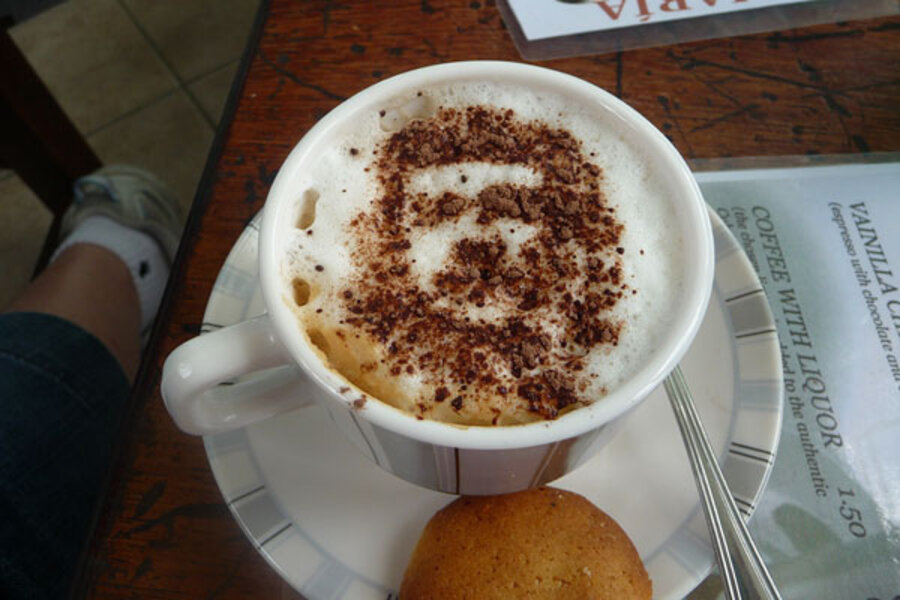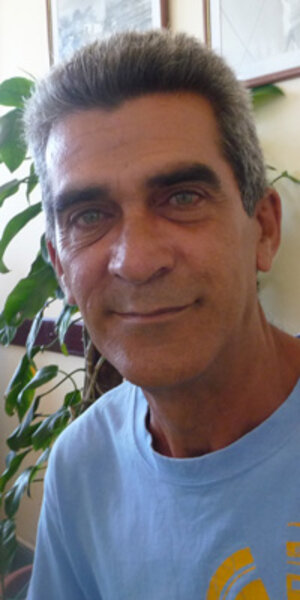Move over Beyoncé: Another American explores Cuba, 'people to people'
Loading...
| Cojimar, Cuba
Raul leans forward, at the end of a satisfying lunch of seafood and flan, and asks me a favor.
“Please give a message to Obama,” says the deeply tan fisherman with electric eyes. The crucial message that I am to personally deliver to the leader of the free world: that the president has a kindred spirit in Cuba. “He is a mason, and I am a mason,” Raul says.
I have my doubts about the first half of the message, but no matter. Our table of visiting Americans – plus Osvaldo, our Cuban guide – has had quite the conversation with Raul Sierra Carriles, president of the local fishermen’s cooperative.
Raul told of the 350-pound marlin he caught two years ago, which took an hour to reel in with a heavy line and lots of hooks. He talked about the cigarette boats he has seen speed by as he fishes far offshore, and the time one offered to take him and his crewman to Florida. They declined.
Inevitably, the discussion turns to Ernest Hemingway, who lived nearby for 20 years and used to keep his fishing boat, the Pilar, at the marina here in Cojimar, near Havana. Raul is a bit too young to have known Hemingway, but he knew Gregorio Fuentes, Hemingway’s boat captain, who died in 2002 at the age of 104. The walls of the restaurant – an old Hemingway haunt named La Terraza – are crowded with pictures of “Papa” and the old man.
Mind you, we are told, Hemingway insisted that Santiago, the main character in “The Old Man and the Sea,” was based on no one in particular. But if I ever read the book again, Fuentes’s weathered face will surely come to mind.
It is the final day of a jam-packed week in Cuba, and I am pinching myself. I’ve just had lunch with a guy who knew a guy who knew Hemingway.
But I am not here on a journalist’s visa. Nor did I sneak in illegally, in violation of the five-decade US trade embargo with the island. Like Beyoncé and Jay-Z, who traveled to Cuba just a couple of weeks before us, my mother and I are here on a “people to people” tour – since 2011, a legal way for Americans to see this long-forbidden island just a short flight from Miami to Havana. Until then, legal travel was limited to family visits and other restricted categories, such as academic, cultural, and humanitarian.
Technically, Beyoncé and Jay-Z weren’t tourists, and neither were we. Our trips were set up by tour operators licensed by the Treasury Department, and under the rules, we were to have a “full-time schedule of educational exchange activities that will result in meaningful interaction between the travelers and individuals in Cuba.” The idea is to support Cuban civil society. For the Cubans, the trips help their economy.
To many Americans, the allure of Cuba is clear: It is the largest island in the Caribbean, steeped in culture – music, literature, art, dance, food – and the storied homeland of so many Cuban-Americans who lost it all when Fidel Castro took over in 1959.
Everyone in our group wanted to see the place before the Castros depart the scene and, sooner or later, the island becomes just another stop for the cruise lines. As a former Moscow correspondent, I was expecting the Soviet Union with palm trees. I wasn’t far off.
Start with the revolutionary billboards and slogans plastered on buildings. Right there at José Martí International Airport, overlooking the parking lot, there it is – the handsome, iconic face of Che Guevara looking sternly off into the distance. More than former President Fidel Castro or his successor, brother Raul, or even national hero José Martí, Che’s visage is everywhere – even stenciled with powdered chocolate onto the foam of a cappuccino.
The condition of the buildings also suggests 1980s Moscow. In many neighborhoods, block after block of shabby, crumbling infrastructure tell visitors all they need to know about a state-run economy. At least Old Havana and other tourist areas are restored, or under renovation, thanks in part to foreign investment.
Just like in the movies, classic 1950s American cars really are ubiquitous, a source of pride for the ingenious Cubans who manage to keep them running. There are also plenty of Soviet-era cars – mostly the little boxy Ladas and Moskviches. Then there are the new cars – Hyundais, BMWs, Fiats – driven by the Cuban 1 percent.
Still, the people-to-people dimension of our trip is what gave it the juice. Any visitor can drive around and look at the monuments and visit Hemingway’s favorite bars in Old Havana – and even head to the suburb of San Francisco de Paula to visit Finca Vigia, the Hemingway residence-museum, where the Pilar is on display. We did all of that.
But in keeping with Treasury Department requirements, our tour operator, the Grand Circle Foundation, filled much of our time with Cuban people: artists and intellectuals, musicians, schoolchildren, senior citizens at a Catholic center, young “street opera” performers, a tobacco farmer, the fishermen of Cojimar. We got lectures on music and baseball, a tour of an orchid farm, and a crash course on Santeria, a widely practiced African faith. Leo, our American guide, took us to his favorite paladar, or private restaurant, in Havana – Doña Eutimia.
Sometimes we created our own “people to people” moments, such as the game of dominoes some in our group had with locals. There was also free time at night to head out to jazz clubs.
We also got out of Havana for a few days, heading west into the scenic Viñales Valley, famous for its box-shaped hills known as mogotes and tobacco farms. In the town of Viñales, we fanned out to private homes for dinner. Our hosts, Teresa and Severo, proudly told us about the bed and breakfast they run out of their house, a practice allowed by the government since 1997. Teresa showed us her appointment calendar, booked with guests from all over the world. A night at their place goes for 25 convertible pesos (about $30).
Of course, throughout the trip, we were interacting with “government approved” Cubans, who met often with American tour groups, they admitted. The phrase “people to people” itself contains echoes of the old Soviet Union, and the days of “fellow travelers” who were more than willing to put a happy gloss on the often tragic outcomes of dictatorial rule. To flesh out what I was seeing, during the trip I read the book “Havana Real” by Cuban dissident blogger Yoani Sánchez.
But even without Ms. Sánchez’s book, there’s no hiding the struggles of daily life for average Cubans, who still get their food via a ration system. Grand Circle advised us to bring gifts – not trinkets, but everyday necessities, such as toothpaste, shampoo, cleaning supplies, powdered milk, socks, shoes (didn’t have to be new), and granola bars. For the fishermen, we were to bring fishing line, leaders, hooks, and lures. For the kids, art supplies, clothing, and athletic equipment. I threw in two scuffed baseballs, and was assured they would be welcome.
Our guide Osvaldo, a former high school teacher, fielded our endless questions with good humor. We heard about his teenage son, who likes to watch “Friends” and “Vampire Diaries” and recordings of Boston Red Sox games. We heard about the high divorce rate, and the challenges of live-in mothers-in-law. We got an update on Elian Gonzalez, the Cuban boy who was the subject of a fierce custody battle with the US back in 2000. Elian is now 19, a young communist, and a student at a Cuban military academy.
Embarrassment was a running theme. To Osvaldo, the drab Soviet-era architecture dominating some neighborhoods is an insult to Cuban aesthetic sensibilities. But nothing says former imperial overlord like the former Soviet (now Russian) Embassy, a garish, sword-shaped tower of concrete rising above Havana’s upscale Miramar neighborhood.
The moist poignant moment of our trip came at Havana’s Museo Nacional de Bellas Artes. As we entered, we were assaulted by the odor of melting paint. The air conditioning was broken; the necessary part was reportedly on its way from Canada. Our guide, Wifredo, spoke of his embarrassment as we sweated our way through the exhibitions.
By the end of the museum tour, only two of us were still with Wifredo. But he was determined to show us his favorite piece. It was the word “Revolución,” constructed from dinged-up, recycled building materials – rusted metal, bathroom tile, old plaster. He didn’t need to say why it spoke to him so profoundly.







